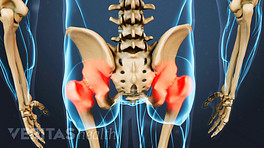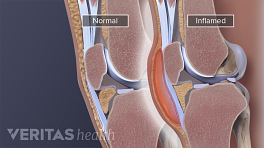The underlying causes of hip bursitis vary widely, ranging from an obvious trauma to a systemic disease such as gout. In addition, some people are at greater risk for hip bursitis because of their anatomy. Identifying the underlying cause of hip bursitis symptoms can help guide treatment and help prevent future flare ups.
In This Article:
The most common causes and risk factors include:
- Hip injury or trauma. Falling on the outside of the hip, or banging the hip on any hard surface, can cause the bursa to fill with blood and/or its lining to become inflamed. Even though the blood may be reabsorbed into the body, the bursa lining may stay inflamed, causing bursitis symptoms. This condition is termed traumatic hip bursitis.
- Repetitive pressure or friction. Hip bursitis can be caused by repetitive mini-traumas to the bursa. These mini-traumas can cause the same problems as a single, more serious trauma. For example, people who bike, run, or climb stairs regularly may be more prone to hip bursitis. 1 Seidman AJ, Varacallo M. Trochanteric Bursitis. 2019 Jan;. Review. PubMed PMID: 30860738.
- Certain medical conditions. Hip bursitis is more likely to develop in people who are already prone to joint pain from other inflammatory conditions, such as rheumatoid arthritis and gout.
- Excess weight. Being overweight can affect gait and/or put excess strain on the hip joint, increasing the risk for hip bursitis.
- Problems that affect biomechanics. Certain physical conditions, such as scoliosis, low back problems, and differences in leg length, can alter the hips’ biomechanics. Walking or running on uneven ground can also affect biomechanics. The change in biomechanics can have a domino effect that results in pain at the side of the hip.
- Bone spurs or calcium deposits. Hip bursae and other soft tissue can become irritated by bone spurs, also called osteophytes, and calcium deposits, which are small collections of calcium that are often small and soft but can grow and harden over time.
- Previous hip surgery. A surgery at or even near the hip can increase the likelihood of developing hip bursitis.
- Age and gender. Women are more likely to report pain at the side of the hip than men. 2 Segal NA, Felson DT, Torner JC, et al. Greater trochanteric pain syndrome: epidemiology and associated factors. Arch Phys Med Rehabil. 2007;88(8):988–992. doi:10.1016/j.apmr.2007.04.014 Though people of any age can be affected, people in their 40s, 50s and 60s are more likely to have hip bursitis. 3 Fearon AM, Cook JL, Scarvell JM, Neeman T, Cormick W, Smith PN. Greater trochanteric pain syndrome negatively affects work, physical activity and quality of life: a case control study. J Arthroplasty. 2014 Feb;29(2):383-6. As cited in Seidman AJ, Varacallo M. Trochanteric Bursitis. 2019 Jan;. Review. PubMed PMID: 30860738.
- History of inflammation of the bursa. Patients who have had bursitis in the past are more likely than others to get it again. When bursitis persists or re-occurs it is called chronic bursitis.
- Bacterial infection of a bursa. An infection of the trochanteric bursa is called septic hip bursitis. Certain medical conditions and medications that suppress people's immune systems can make them more susceptible to septic bursitis. For example, people with diabetes, alcoholism, chronic obstructive pulmonary disease (COPD), gout, and rheumatoid arthritis may be more likely to get septic bursitis.
4
Reilly D, Kamineni S. Olecranon bursitis. J Shoulder Elbow Surg. 2016 Jan;25(1):158-67. doi: 10.1016/j.jse.2015.08.032. Epub 2015 Nov 11. Review. PubMed PMID: 26577126.
,
5
Roschmann RA, Bell CL. Septic bursitis in immunocompromised patients. Am J Med 1987; 83: 661–665.
,
6
Truong J, Ashurst JV. Septic Bursitis. 2019 Jan;. Review. PubMed PMID: 29262131.
See Septic Bursitis
During the diagnostic process, accurate information about the patient’s medical history, occupation, hobbies, and possible recent traumas can provide clues regarding the underlying cause of hip bursitis.
- 1 Seidman AJ, Varacallo M. Trochanteric Bursitis. 2019 Jan;. Review. PubMed PMID: 30860738.
- 2 Segal NA, Felson DT, Torner JC, et al. Greater trochanteric pain syndrome: epidemiology and associated factors. Arch Phys Med Rehabil. 2007;88(8):988–992. doi:10.1016/j.apmr.2007.04.014
- 3 Fearon AM, Cook JL, Scarvell JM, Neeman T, Cormick W, Smith PN. Greater trochanteric pain syndrome negatively affects work, physical activity and quality of life: a case control study. J Arthroplasty. 2014 Feb;29(2):383-6. As cited in Seidman AJ, Varacallo M. Trochanteric Bursitis. 2019 Jan;. Review. PubMed PMID: 30860738.
- 4 Reilly D, Kamineni S. Olecranon bursitis. J Shoulder Elbow Surg. 2016 Jan;25(1):158-67. doi: 10.1016/j.jse.2015.08.032. Epub 2015 Nov 11. Review. PubMed PMID: 26577126.
- 5 Roschmann RA, Bell CL. Septic bursitis in immunocompromised patients. Am J Med 1987; 83: 661–665.
- 6 Truong J, Ashurst JV. Septic Bursitis. 2019 Jan;. Review. PubMed PMID: 29262131.











